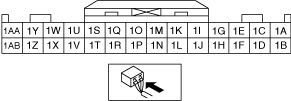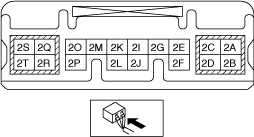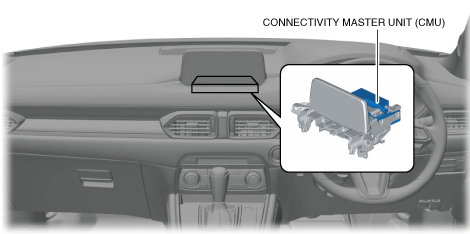CONNECTIVITY MASTER UNIT
id092000113400
Purpose/Function
• The connectivity master unit (CMU) controls the entire system such as communication between mobile devices and Bluetooth®, and the sending/receiving of video/audio signals from units related to the entertainment system.
Bluetooth® communication function
-
• The CMU uses the integrated Bluetooth® driver and antenna to perform communication between Bluetooth®-enabled devices and Bluetooth®.
-
• To perform Bluetooth® communication, pairing of a Bluetooth®-enabled device with the CMU is required to specify the device. For the pairing method, refer to the [Bluetooth® PAIRING PROCEDURE] in the workshop manual.
Specification
|
Item
|
Content
|
|
Compatible profiles
|
A2DP 1.0/1.2 (Advanced audio distribution profile)
|
A2DP is a profile for transmitting high quality audio data by means of a Bluetooth® device and wireless transmission technology.
|
|
AVRCP 1.0/1.3/1.4 (Audio/video remote control profile)
|
AVRCP is a profile which provides a standard interface which controls television and audio devices. The function differs depending on the version.
|
|
Maximum number of programmable devices
|
7
|
|
Number of Bluetooth®-enabled devices which can be used simultaneously
|
2*1
|
*1 :A Hands-free call can be placed using another Bluetooth®-enabled device during audio playback using the other Bluetooth®-enabled device.
-
Note
-
• The profile indicates the wireless communication standard. If the profile of the Bluetooth®-enabled device differs from the CMU, wireless transmission may not be possible. In addition, depending on the profile version, the corresponding functions differ.
Operation signal reception function
-
• The CMU controls units related to the entertainment system based on the following operation signals which are sent in conjunction with the user operations from the operation signal output unit.
|
Operation signal output unit
|
Operation signal
|
|
Center display
|
LVDS signal (touch position operation signal)
|
|
Commander switch
|
Commander switch operation signal
|
|
Steering switch
|
Steering switch operation signal
|
|
Voice recognition microphone
|
Voice signal (voice command)
|
LVDS*2 signal conversion function
-
Note
-
• Communication between the CMU and the center display is performed via the LVDS communication line.
-
• The CMU converts signals sent from the following units to a LVDS signal and displays each type of information in the center display.
|
Output unit
|
Video signal/display request signal
|
|
Tuner and amp unit (TAU)
|
• Radio broadcast logo, album art, song name
• Traffic information such as location and length of traffic jams
|
|
Auxiliary jack/USB port/SD card slot hub
|
• Information for file being played (artist/song name)
|
|
Devices such as Bluetooth®-enabled mobile phones and or mobile devices such as Smartphones/Bluetooth®-enabled devices
|
• Telephone book, incoming call record
• Radio broadcast logo, album art, song name
|
|
Rear mount camera
|
• Image at rear of vehicle
|
|
360° view monitor control module
|
• Image at vehicle front
• Image on left front side of vehicle
• Image at rear of vehicle
• Image around vehicle from top of vehicle
|
|
CMU
|
• Incoming call pop-up screen display
• Fuel monitor screen
• Warning guidance screen display
• Navigation screen display
• Temperature warning pop-up screen display
|
-
• By converting the video signal to a LVDS signal, the CMU is able to display stable images in the center display virtually free from the effects of noise.
-
• The LVDS communication pathway between the CMU and the center display corresponds to HDCP*3.
*2 :The LVDS displays the electrical properties of the signal using low-voltage differential signaling. LVDS is a digital, wired transmission technology for the short range which adopts a differential interface having the characteristics of low voltage and low power consumption.
*3 :HDCP (High-bandwidth Digital Content Protection system) is a copyright protection technology which prevents content from being copied fraudulently. The pathway in a display device such as a display, which sends/receives digital signals from a video playback device such as a computer, is encrypted.
Audio transmission signal function
-
• The CMU sends the audio signal received from the following units to the TAU.
-
― Auxiliary jack/USB port/SD card slot hub
― Devices such as Bluetooth®-enabled mobile phones and or mobile devices such as Smartphones/Bluetooth®-enabled devices
• The CMU receives audio signals from the voice recognition microphone and performs control according to the commands.
TA (traffic announcement) function
-
• If the TAU receives a TA broadcast while listening to the following modes, the CMU switches the audio to the TA broadcast automatically. In addition, the traffic alert screen is displayed in the center display.
-
― FM radio
― USB
― AUX
― Bluetooth® audio
― Aha™ radio
― Sticher™ radio
• When the TA broadcast has finished, the audio unit returns to the mode that was being listened to before the TA broadcast. In addition, the center display cancels the traffic alert screen display and displays the screen prior to the traffic alert screen.
Traffic announcement screen
|
Button
|
Content
|
|
TA off
|
• Cancels the TA broadcast playback and traffic alert screen display, and displays the screen prior to the traffic alert screen.
• Sets the TA (traffic announcement) function to OFF.
|
|
Cancel
|
Cancels the TA broadcast playback and traffic alert screen display, and displays the screen prior to the traffic alert screen.
|
|
Remove
|
Cancels the traffic alert screen display and displays the screen prior to the traffic alert screen.
|
-
Note
-
• If the TA (traffic announcement) function is set to OFF, the audio does not switch automatically to TA broadcasts even if a TA broadcast is received.
Fuel economy function
-
• The CMU receives the fuel consumption amount and travel distance information signal from the instrument cluster and displays it in the center display as the fuel economy monitor. For details, refer to the fuel economy monitor of the [CENTER DISPLAY]. (See
CENTER DISPLAY.)
Navigation function
-
• The CMU performs map display and route guidance based on the position information received from the GPS antenna and the map information received from the auxiliary jack/USB port/SD card slot hub. For details, refer to the [ENTERTAINMENT SYSTEM] navigation function. (See
ENTERTAINMENT SYSTEM.)
-
Turn-by-turn (TBT)
-
• The turn-by-turn (TBT) function displays the travel direction of the route guidance in the active driving display. The turn-by-turn (TBT) operates when all of the following conditions have been met. For details, refer to the navigation function turn-by-turn (TBT) of the [ENTERTAINMENT SYSTEM]. (See
ENTERTAINMENT SYSTEM.)
-
― Route guidance of navigation function is operating
― Navigation guidance is set to ON using the personalization function for the active driving display
• The CMU sends the turn-by-turn (TBT) display request signal to the instrument cluster to display the direction heading and distance in the [ACTIVE DRIVING DISPLAY]. (See
ACTIVE DRIVING DISPLAY.)
Automatic configuration function
-
• When the ignition is switched ON (engine off or on) after the CMU is replaced, the CMU reads the vehicle specification information sent from the instrument cluster, and stores the vehicle specification information.
On-board diagnostic function
-
• The CMU has an on-board diagnostic function to facilitate system diagnosis. DTCs are stored in the event of a malfunction occurring. For details, refer to the [ON-BOARD DIAGNOSTIC]. (See
ON-BOARD DIAGNOSTIC [ENTERTAINMENT SYSTEM].)
Diagnostic assist function
-
-
― Connection status of related parts
― Operation status of related parts
― Related part specifications
Structure/Construction
• The CMU is located centrally inside the dashboard.
• The CMU has an integrated Bluetooth® driver and antenna.
Input/output signal table
|
Terminal
|
Signal
|
 |
1A
|
Video signal input *4
|
|
1B
|
Video signal ground*4
|
|
1C
|
Camera power supply *4
|
|
1D
|
Camera power supply ground*4
|
|
1E
|
—
|
|
1F
|
—
|
|
1G
|
—
|
|
1H
|
—
|
|
1I
|
—
|
|
1J
|
—
|
|
1K
|
—
|
|
1L
|
—
|
|
1M
|
Steering1 switch input
|
|
1N
|
Steering2 switch ground input
|
|
1O
|
Steering3 switch input
|
|
1P
|
Microphone connection detection
|
|
1Q
|
Microphone power supply
|
|
1R
|
Microphone power supply ground
|
|
1S
|
Microphone voice input (+)
|
|
1T
|
Microphone voice input (-)
|
|
1U
|
—
|
|
1V
|
—
|
|
1W
|
—
|
|
1X
|
—
|
|
1Y
|
CMU audio output LH (+)
|
|
1Z
|
CMU audio output LH (-)
|
|
1AA
|
CMU audio output RH (+)
|
|
1AB
|
CMU audio output RH (-)
|
 |
2A
|
—
|
|
2B
|
—
|
|
2C
|
Ground
|
|
2D
|
Ground
|
|
2E
|
HS-CAN_H
|
|
2F
|
HS-CAN_L
|
|
2G
|
—
|
|
2I
|
Local HS-CAN_H
|
|
2J
|
Local HS-CAN_L
|
|
2K
|
LIN communication
|
|
2L
|
Ground
|
|
2M
|
—
|
|
2O
|
RS485 signal (+)
|
|
2P
|
RS485 signal (-)
|
|
2Q
|
ACC
|
|
2R
|
B+
|
|
2S
|
—
|
|
2T
|
—
|
 |
3A
|
—
|
|
3B
|
LVDS (+)
|
|
3C
|
—
|
|
3D
|
LVDS (-)
|
 |
4A
|
Ground
|
|
4B
|
USB data (+)
|
|
4C
|
USB power supply
|
|
4D
|
USB data (-)
|
 |
5A
|
GPS
|
|
5A'
|
Ground
|
*4 :With parking assist system
Operation
Fail-safe
• If the CMU receives an electrical signal (LVDS signal) of a temperature of approx. 82 C°{180 F°} or more from the center display, it performs the following controls:
-
― Sends a temperature warning pop-up screen display request signal to the center display and displays the temperature warning pop-up screen on the LCD.
― Temporarily lowers the brightness of the center display LCD. This is to protect the center display LCD and the circuit.





